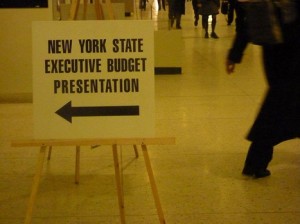New York State’s 2012 draft budget gave transportation some much-needed attention. If the plan is adopted, the state will dispense $4.4 billion to New York’s transit systems ($4 billion to the MTA and $430 million to non-MTA systems). The increase in aid comes from tax restructuring and revenue increases from various dedicated taxes (MMTOA) that pay for transit.
Here are some of the budget’s notable transportation components:
Upstate transit systems get attention: upstate bus systems have long struggled to deliver service. Bus systems currently receive revenue from the petroleum business tax, which has brought in less money over the years. To address this, the Governor proposed a redistribution of the Transmission Tax (also known as the “Long Lines Tax”) more equitably between downstate and upstate systems. Instead of a yearly transfer of tax revenue between upstate and downstate, funds would be distributed based on population. This would bring in an additional $11 million in aid to upstate transit systems. NYSTEA and TSTC have pointed out that existing funding structures have proven inadequate for upstate transit systems; this reform is a good start towards the broader fixes which will be needed.
The MTA gets paid back: thanks to pressure from transit advocacy groups, Governor Cuomo’s proposed budget keeps his promise to fill the $310 million gap in the MTA’s budget caused by the reformed payroll mobility tax deal in December. The restructuring worried transit advocates, who feared that the drop in yearly revenue would trigger another fare increase and service cut in 2012. State sources indicate that the MTA will be compensated for the full $310 million over the state’s fiscal year (which runs April 1 through March 31). The state would also reimburse the MTA for costs associated with an EZ Pass rebate program for Queens residents that use the Cross Bay Veterans Memorial Bridge.
The MTA Capital Program gets additional state commitment: the state would give an additional $770 million over the remaining three years of the MTA’s construction effort. This aid would be accompanied by a $7 billion increase in the MTA’s debt ceiling (from $34 billion to $41 billion), which would finance the bulk of the capital program. State legislation is required for this action.
Tappan Zee bridge construction bill has not been resolved: the Governor reiterated his proposal to fund the Tappan Zee Bridge replacement project with $5 billion from a New York Works Infrastructure Fund, with the New York State Thruway Authority being the responsible entity. It is still unclear how the Thruway Authority would pay for the replacement, though increased tolls and taxes seem to be the most likely options. Meanwhile, BRTontheBridge.org was launched earlier this month to advocate for a bridge replacement plan that includes the public transportation communities need.
The draft budget is already having an effect. In Buffalo, where the Niagara-Frontier Transportation Authority (NFTA) is about to start hearings on a proposed 22% cut in service miles, transit riders are making their voices heard. According to NFTA Executive Director, Kimberley A. Minkel, the extensive public comment and the additional money from Albany has the Authority considering a change of direction—they’re now considering a $.25 increase in fares and a 5% cut in service instead.
Veronica Vanterpool is associate director of the Tri-State Transportation Campaign, a member of the NYSTEA steering committee.


 0 Comments
0 Comments  Print
Print
 Email
Email